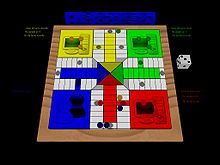Parchís
Parchís is a Spanish descendant of Pachisi . It is closely related to the German Eile mit Weile .
terminology
The Spaniards have given the individual elements their own names:
- The colored corners are called cárceles ( prisons ) or casas ( houses ).
- The rectangular fields in your own playing color are called salidas ( exits ).
- The rectangular fields in a different color or the white with gray dots are called seguros ( safe fields ).
- The triangular fields in the middle are called metas ( targets ).
- Blocking two pieces of the same color is called a barrera ( barriers ) or puente ( bridges ).
- The numerals siete ( seven ), diez ( ten ) and veinte ( twenty ) indicate how many spaces a pawn may advance.
- Beating an opposing piece is called a comer (to eat ) or capturar (to take prisoner ).
Course of the game
The game consists of a game board with a circuit made up of numbered fields (1 - 68). This will make counting easier when you are making a figure. If an opposing piece is captured, the winner may advance twenty spaces. A player can also move ten spaces with another piece if he has brought a piece to the goal. The rules of the dice are analogous to the German game Eile mit Weile : A player who has thrown a five is allowed to pull out of his own corner. A six can be rolled again. With three times six, however, all of your own pieces that are not yet in the middle must be put back in the corner. The six counts twice.
software
There is an open source software implementation of this game called glParchís . The gl in the name comes from OpenGL , an open source graphics library that is independent of the operating system .
Web link
Individual evidence
- ↑ a b Erwin Glonnegger : The games book. Board and placement games from all over the world. Origin, rules and history. Ravensburger Buchverlag Otto Maier et al., Ravensburg et al. 1988, ISBN 3-473-42601-6 .

